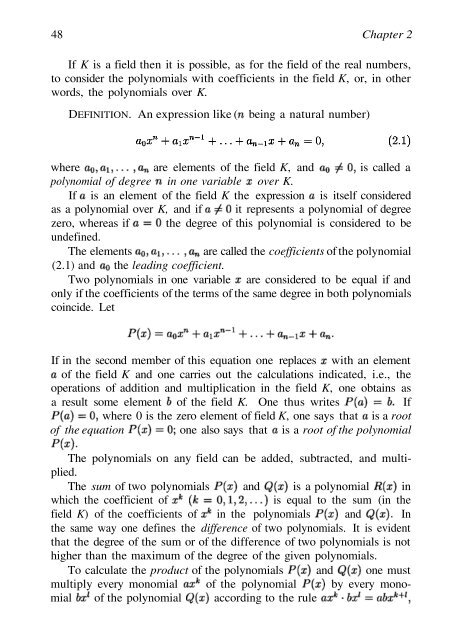Abel's theorem in problems and solutions - School of Mathematics
Abel's theorem in problems and solutions - School of Mathematics
Abel's theorem in problems and solutions - School of Mathematics
Create successful ePaper yourself
Turn your PDF publications into a flip-book with our unique Google optimized e-Paper software.
48 Chapter 2<br />
If K is a field then it is possible, as for the field <strong>of</strong> the real numbers,<br />
to consider the polynomials with coefficients <strong>in</strong> the field K, or, <strong>in</strong> other<br />
words, the polynomials over K.<br />
DEFINITION. An expression like ( be<strong>in</strong>g a natural number)<br />
where are elements <strong>of</strong> the field K, <strong>and</strong> is called a<br />
polynomial <strong>of</strong> degree <strong>in</strong> one variable over K.<br />
If is an element <strong>of</strong> the field K the expression is itself considered<br />
as a polynomial over K, <strong>and</strong> if it represents a polynomial <strong>of</strong> degree<br />
zero, whereas if the degree <strong>of</strong> this polynomial is considered to be<br />
undef<strong>in</strong>ed.<br />
The elements are called the coefficients <strong>of</strong> the polynomial<br />
(2.1) <strong>and</strong> the lead<strong>in</strong>g coefficient.<br />
Two polynomials <strong>in</strong> one variable are considered to be equal if <strong>and</strong><br />
only if the coefficients <strong>of</strong> the terms <strong>of</strong> the same degree <strong>in</strong> both polynomials<br />
co<strong>in</strong>cide. Let<br />
If <strong>in</strong> the second member <strong>of</strong> this equation one replaces with an element<br />
<strong>of</strong> the field K <strong>and</strong> one carries out the calculations <strong>in</strong>dicated, i.e., the<br />
operations <strong>of</strong> addition <strong>and</strong> multiplication <strong>in</strong> the field K, one obta<strong>in</strong>s as<br />
a result some element <strong>of</strong> the field K. One thus writes If<br />
where 0 is the zero element <strong>of</strong> field K, one says that is a root<br />
<strong>of</strong> the equation one also says that is a root <strong>of</strong> the polynomial<br />
The polynomials on any field can be added, subtracted, <strong>and</strong> multiplied.<br />
The sum <strong>of</strong> two polynomials <strong>and</strong> is a polynomial <strong>in</strong><br />
which the coefficient <strong>of</strong> is equal to the sum (<strong>in</strong> the<br />
field K) <strong>of</strong> the coefficients <strong>of</strong> <strong>in</strong> the polynomials <strong>and</strong> In<br />
the same way one def<strong>in</strong>es the difference <strong>of</strong> two polynomials. It is evident<br />
that the degree <strong>of</strong> the sum or <strong>of</strong> the difference <strong>of</strong> two polynomials is not<br />
higher than the maximum <strong>of</strong> the degree <strong>of</strong> the given polynomials.<br />
To calculate the product <strong>of</strong> the polynomials <strong>and</strong> one must<br />
multiply every monomial <strong>of</strong> the polynomial by every monomial<br />
<strong>of</strong> the polynomial accord<strong>in</strong>g to the rule

















